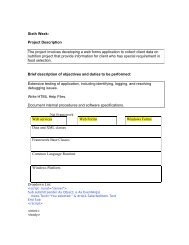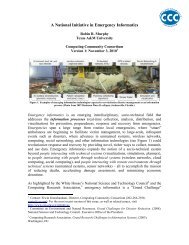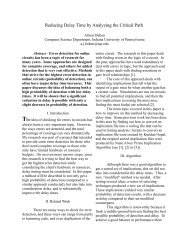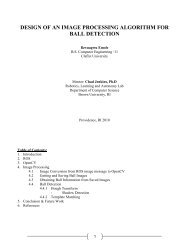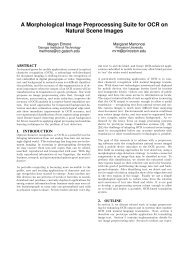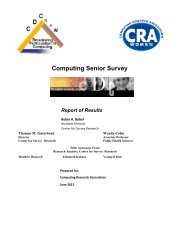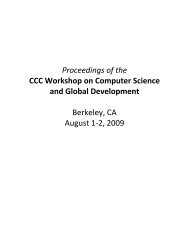Using a Multidimensional Approach to Predict Motivation and ...
Using a Multidimensional Approach to Predict Motivation and ...
Using a Multidimensional Approach to Predict Motivation and ...
Create successful ePaper yourself
Turn your PDF publications into a flip-book with our unique Google optimized e-Paper software.
Topics in Geriatric Rehabilitation<br />
Vol. 21, No. 3, pp. 182–193<br />
c○ 2005 Lippincott Williams & Wilkins, Inc.<br />
<strong>Using</strong> a <strong>Multidimensional</strong> <strong>Approach</strong><br />
<strong>to</strong> <strong>Predict</strong> <strong>Motivation</strong> <strong>and</strong> Adherence<br />
<strong>to</strong> Rehabilitation in Older Adults<br />
Emma J. Grindley, EdD; Samuel J. Zizzi, EdD<br />
Physical therapists working with older adults often encounter problems related <strong>to</strong> low motivation<br />
<strong>and</strong> adherence. This review article integrates data on fac<strong>to</strong>rs related <strong>to</strong> adherence behavior<br />
from the fields of sports medicine, sport psychology, athletic training, <strong>and</strong> physical therapy <strong>and</strong><br />
applies the results <strong>to</strong> older adults in rehabilitation. Key fac<strong>to</strong>rs are highlighted <strong>and</strong> a model for<br />
predicting adherence behavior, based on protection motivation theory, is outlined. The authors<br />
advocate complementing orthopedic assessment with a psychosocial assessment in the form<br />
of brief surveys or structured interview. The article concludes with several evidence-based recommendations<br />
for the practicing physical therapist. Key words: adherence, rehabilitation,<br />
review<br />
ASSESSING patient motivation <strong>and</strong> predicting<br />
adherence <strong>to</strong> rehabilitation may<br />
present a difficult situation for a physical therapist<br />
(PT) or sports medicine professional<br />
(SMP). Licensed PTs <strong>and</strong> SMPs are trained<br />
<strong>to</strong> be competent in many areas within the<br />
health sciences, but may have less confidence<br />
in counseling, psychological assessment, or<br />
mental skills training. 1–3 Ye<strong>to</strong>nadaily basis,<br />
practitioners are faced with interpersonal<br />
evaluations <strong>and</strong> are asked <strong>to</strong> create rehabilitation<br />
programs for a variety of patients with<br />
differing skills, goals, <strong>and</strong> needs. A client’s perceptions,<br />
motivation, <strong>and</strong> adherence behavior<br />
can greatly impact rehabilitation progress;<br />
<strong>and</strong> expecting all PTs <strong>and</strong> SMPs <strong>to</strong> successfully<br />
navigate these uncharted waters may be unrealistic.<br />
Numerous studies have identified key<br />
fac<strong>to</strong>rs related <strong>to</strong> patient motivation <strong>and</strong> adherence,<br />
but guidelines for translating these<br />
research findings in<strong>to</strong> practice have not been<br />
From the School of Physical Education, West Virginia<br />
University, Morgan<strong>to</strong>wn.<br />
Corresponding author: Samuel J. Zizzi, EdD, School<br />
of Physical Education, West Virginia University, PO<br />
Box 6116, Morgan<strong>to</strong>wn, WV 26506 (e-mail: szizzi@<br />
mail.wvu.edu).<br />
182<br />
fashioned. Further, only one text in the field<br />
of physical therapy has exclusively addressed<br />
psychological fac<strong>to</strong>rs related <strong>to</strong> geriatric rehabilitation<br />
in the last 15 years. 4 This text,<br />
Psychological Aspects of Geriatric Rehabilitation,<br />
isauseful sourcebook. However, the<br />
authors focus on lower-functioning patients<br />
<strong>and</strong> clinical disorders that may interfere with<br />
rehabilitation.<br />
Carefully examining the broad literature<br />
base on rehabilitation allows the informed<br />
consumer <strong>to</strong> glean important lessons for the<br />
practice of physical therapy with older adults.<br />
The underlying assumption of this work is<br />
that PTs would prefer <strong>to</strong> have motivated<br />
patients who closely follow their recommendations<br />
<strong>and</strong> that regularly working with motivated<br />
patients would increase job satisfaction.<br />
Psychosocial research has assessed a variety of<br />
fac<strong>to</strong>rs that may facilitate or interfere with a<br />
patient’s motivation, <strong>and</strong> if providers can identify<br />
<strong>and</strong> reduce barriers early in rehabilitation,<br />
the patient may respond positively. This increased<br />
motivation would lead <strong>to</strong> improved<br />
adherence <strong>to</strong> the rehabilitation pro<strong>to</strong>col <strong>and</strong><br />
an increased likelihood of positive health<br />
outcomes.<br />
Health science <strong>and</strong> sport psychology<br />
researchers have examined rehabilitation
MOTIVATION AND ADHERENCE TO REHABILITATION<br />
adherence over the past 2 decades, <strong>and</strong> more<br />
than 200 potential mediating variables have<br />
emerged. 5 With this proliferation of research,<br />
though, has come considerable confusion for<br />
applied professionals in discerning which<br />
fac<strong>to</strong>rs <strong>to</strong> focus on when evaluating new<br />
patients. Should you focus on pain <strong>and</strong> pain<br />
<strong>to</strong>lerance or is the patient’s lack of confidence<br />
more important? Is it critical <strong>to</strong> address the<br />
patients’ perceived barriers ahead of time or<br />
just wait for them <strong>to</strong> emerge? Contributing<br />
<strong>to</strong> the problem, it has been common for<br />
previous research related <strong>to</strong> motivation<br />
<strong>and</strong> adherence <strong>to</strong> examine 1 or 2 fac<strong>to</strong>rs<br />
in isolation. While these unidimensional<br />
studies are helpful in assembling the pieces<br />
of the adherence puzzle, they do not provide<br />
a clear or practical solution <strong>to</strong> assessing<br />
patient motivation, neither do they allow for<br />
a comparison of the multiple fac<strong>to</strong>rs that are<br />
likely <strong>to</strong> influence patient behavior.<br />
The purpose of this review article is <strong>to</strong><br />
offer a theoretical framework for the study<br />
of motivation <strong>and</strong> adherence <strong>to</strong> rehabilitation<br />
among older adults. The review draws from<br />
the fields of sports medicine, sport psychology,<br />
athletic training, <strong>and</strong> physical therapy<br />
<strong>and</strong> applies the findings <strong>to</strong> older adults. There<br />
is a dearth of research literature on adherence<br />
<strong>and</strong> motivation among physical therapy patients<br />
in general, <strong>and</strong> more specifically, there<br />
is a void in the literature exploring these issues<br />
within a geriatric population. The majority<br />
of the information discussed within this review<br />
will be most relevant for moderate- <strong>to</strong><br />
high-functioning geriatric patients with subacute<br />
<strong>and</strong> acute injuries. Hopefully, reviewing<br />
the relevant findings related <strong>to</strong> adherence <strong>to</strong><br />
rehabilitation in healthy <strong>and</strong> unhealthy populations<br />
will highlight methods that could<br />
be used <strong>to</strong> complement traditional rehabilitation<br />
programs by identifying patients’ dysfunctional<br />
attitudes <strong>and</strong> barriers <strong>to</strong> rehabilitation<br />
before they emerge. The review will first<br />
discuss adherence rates across situations <strong>and</strong><br />
modalities <strong>and</strong> discuss key fac<strong>to</strong>rs identified<br />
as predictive of adherence in rehabilitation<br />
settings, then offer a theoretical framework<br />
for current <strong>and</strong> future study, <strong>and</strong> conclude<br />
with a section offering evidence-based recommendations<br />
for research <strong>and</strong> practice.<br />
KEY FACTORS RELATED TO<br />
REHABILITATION ADHERENCE<br />
Among allied health providers, the shared<br />
goal of rehabilitation is <strong>to</strong> assist patients in<br />
enhancing their functional abilities <strong>and</strong> return<br />
them, where possible, <strong>to</strong> preinjury health<br />
as efficiently as possible. 6–8 Not surprisingly,<br />
several authors have suggested that adherence<br />
behavior is a major contribu<strong>to</strong>r <strong>to</strong> successful<br />
rehabilitation. 9–12 Although there is an<br />
awareness of this importance, low <strong>to</strong> moderate<br />
adherence rates have been reported in<br />
numerous health-related fields. 13–15 Forexample,<br />
Ice 14 reported 40% <strong>to</strong> 64% adherence<br />
within fitness programs, 25% <strong>to</strong> 75% adherence<br />
in weight reduction programs, <strong>and</strong> 30%<br />
<strong>to</strong> 80% dropout rates in cardiac rehabilitation<br />
programs. Sluijs et al 5 noted that only<br />
35% of their physical therapy sample fully adhered<br />
<strong>to</strong> home exercise regimes. Bassett 16(p65)<br />
suggests that approximately 65% of patients<br />
are “...likely <strong>to</strong> be nonadherent <strong>to</strong> some degree<br />
...,” while Brewer 13 noted 40% <strong>to</strong> 91%<br />
adherence rates in sport injury rehabilitation<br />
settings. Cumulatively, these suggest that rates<br />
have greatly varied <strong>and</strong> are less than optimal.<br />
Higher adherence rates, however, have<br />
been reported within the physical therapy<br />
literature. Vasey 17 completed a survey of<br />
4physiotherapy departments in the United<br />
Kingdom <strong>and</strong> reported that 7% <strong>to</strong> 14% of patients<br />
failed <strong>to</strong> return <strong>to</strong> follow-up appointments,<br />
with 6% <strong>to</strong> 11% failing <strong>to</strong> even attend<br />
their first scheduled appointment. Similar improved<br />
results have been reported in other research,<br />
also ranging from 8% <strong>to</strong> 15%. 7,15,18–21<br />
Because of variations in definitions, measurement,<br />
<strong>and</strong> reporting, it is difficult <strong>to</strong> make firm<br />
conclusions about the research findings presented.<br />
However, it appears that adherence<br />
rates could be improved considerably. Numerous<br />
problems have been noted because<br />
of definitions, research design, instrumentation,<br />
<strong>and</strong> the lack of theory-driven research.<br />
VOL. 21, NO. 3/JULY–SEPTEMBER 2005 183
Methodological concerns have been discussed<br />
at length in previous reviews. 22<br />
The multitude of fac<strong>to</strong>rs related <strong>to</strong> adherence<br />
behavior have commonly been<br />
categorized as either personal or environmental.<br />
Personal fac<strong>to</strong>rs most commonly<br />
reported as affecting adherence rates include<br />
belief in efficacy of treatment, 23–25 selfmotivation,<br />
23,26–31 perceived social support,<br />
23,27,32 pain <strong>to</strong>lerance, 27,29,32 emotional<br />
disturbance, 18,33 belief in ability <strong>to</strong> perform<br />
activities prescribed, 25 goal direction, 23<br />
instrumental coping, 34 positive attitude, 30<br />
perceived risks for future complications<br />
<strong>and</strong> long-term benefits, 25 success perceived<br />
<strong>to</strong> be related <strong>to</strong> controllable fac<strong>to</strong>rs, 26 <strong>and</strong><br />
perceived lack of time. 31<br />
Environmental or situational fac<strong>to</strong>rs<br />
most commonly reported as affecting adherence<br />
rates include clinical setting <strong>and</strong><br />
scheduling, 27,31 communication, 28 therapists<br />
support <strong>and</strong> progression of exercises, 31 <strong>and</strong><br />
rehabilitation professionals’ expectancy of<br />
patient behavior. 25 To date, little has been<br />
done <strong>to</strong> try <strong>to</strong> incorporate this wealth of<br />
information <strong>to</strong> try <strong>to</strong> predict those who may<br />
be at risk for nonadherence. In an effort<br />
<strong>to</strong> develop a more parsimonious model of<br />
adherence, the following discussion will<br />
focus on frequently cited personal fac<strong>to</strong>rs<br />
that influence rehabilitation attitudes <strong>and</strong><br />
behavior.<br />
PERSONAL FACTORS<br />
Self-efficacy <strong>and</strong> self-motivation: Selfefficacy<br />
is a situation-specific construct.<br />
Perceived self-efficacy takes in<strong>to</strong> account<br />
individuals’ conceptualization of the situation<br />
(eg, the dem<strong>and</strong>s of rehabilitation) <strong>and</strong> their<br />
capabilities <strong>to</strong> meet the situational dem<strong>and</strong>s<br />
(eg, their own skill level). Flint 35 reported that<br />
10 athletes recovering from anterior cruciate<br />
ligament (ACL) reconstruction who observed<br />
peers involved in rehabilitation from the same<br />
injury <strong>and</strong> surgery had increased self-efficacy,<br />
self-confidence, <strong>and</strong> adherence <strong>to</strong> rehabilitation.<br />
Evans <strong>and</strong> Hardy 36 reported that a<br />
184 TOPICS IN GERIATRIC REHABILITATION<br />
GRINDLEY <strong>and</strong> ZIZZI<br />
goal setting group had higher levels of selfefficacy<br />
<strong>and</strong> they also had the higher mean<br />
adherence score, although not significantly<br />
different from the control group. Studies<br />
have shown that a specific belief that goal<br />
setting will assist recovery has been shown<br />
<strong>to</strong> positively influence home <strong>and</strong> clinic-based<br />
adherence in several studies. 23,31,37,38 These<br />
findings are likely linked <strong>to</strong> the concept of<br />
self-motivation, which, as previously discussed,<br />
has been cited as a fac<strong>to</strong>r positively<br />
affecting adherence in both qualitative <strong>and</strong><br />
quantitative research efforts.<br />
Perceptions of symp<strong>to</strong>ms: Taylor <strong>and</strong><br />
May 25 reported that more adherent patients<br />
perceived their injury <strong>to</strong> be more serious.<br />
They also reported, along with Brewer <strong>and</strong><br />
colleagues, 39 that those who perceived themselves<br />
<strong>to</strong> be more vulnerable <strong>to</strong> further problems<br />
if they did not follow their rehabilitation<br />
pro<strong>to</strong>col were more adherent. The results<br />
suggest that assessing individuals’ perceptions<br />
of the severity of the injury <strong>and</strong> perceived<br />
susceptibility <strong>to</strong> reinjury may be useful in<br />
identifying cognitive barriers at the onset of<br />
rehabilitation. Although neither of these previously<br />
cited studies dealt specifically with<br />
older adults, these concerns may be highly<br />
relevant in geriatric populations given the<br />
added salience of health concerns among<br />
older adults.<br />
Mood: There have been a variety of models<br />
<strong>to</strong> explain possible reactions <strong>to</strong> injury.<br />
After injury, it is not uncommon for an<br />
individual <strong>to</strong> display negative self-talk, <strong>and</strong><br />
experience anxiety, tension, frustration, or<br />
depression. Cognitive appraisal models from<br />
psychology suggest that these cognitions<br />
<strong>and</strong> subsequent negative emotions can then<br />
affect behavioral responses (ie, decreased adherence).<br />
McDonald <strong>and</strong> Hardy 40 reported a<br />
progression from a negative <strong>to</strong> a more<br />
positive mood state as the rehabilitation progressed,<br />
while other authors have suggested<br />
a curvilinear pattern over extended periods<br />
of rehabilitation. 41 Daly et al 18 reported that<br />
emotional disturbance was inversely related<br />
<strong>to</strong> attendance, yet unrelated <strong>to</strong> PTs’ <strong>and</strong><br />
athletic trainers’ ratings of adherence during
MOTIVATION AND ADHERENCE TO REHABILITATION<br />
sessions. The lack of relationship between<br />
negative mood <strong>and</strong> providers’ rating could<br />
suggest an inability for SMPs <strong>to</strong> recognize<br />
<strong>and</strong> account for mood disturbance among<br />
injured patients. Malec <strong>and</strong> Neimeyer 42 noted<br />
poor adherence in spinal cord injury patients<br />
with psychological distress. This suggests<br />
that emotional disturbance could be a cue<br />
<strong>to</strong> rehabilitation professionals of a patient’s<br />
future poor adherence. Among geriatric<br />
populations, depression <strong>and</strong> other forms of<br />
mood disturbance are even more likely <strong>to</strong><br />
manifest. 43 In addition, elderly depression<br />
may be mistaken for dementia because of the<br />
overlap in symp<strong>to</strong>mology. 44 Rehabilitation<br />
professionals could target these groups for<br />
referral or intervention that would help<br />
address their mood <strong>and</strong> consequently may<br />
positively impact their adherence behavior.<br />
Pain: Kolt <strong>and</strong> McEvoy 7 have suggested<br />
that recovery may be affected by prior pain<br />
experiences. The study did not report on patient’s<br />
pain experiences throughout the study,<br />
which could have also had an effect on their<br />
recovery. The findings also suggest that higher<br />
adherence scores <strong>and</strong> PTs’ first-week estimates<br />
of recovery have some predictive qualities<br />
on future recovery levels. Fisher et al 27<br />
noted that college athletes who were deemed<br />
adherers in their sample <strong>to</strong>lerated pain better.<br />
In another study, adherers <strong>to</strong> rehabilitation<br />
were less concerned with occasional pain<br />
compared <strong>to</strong> those who did not adhere <strong>and</strong><br />
who reported s<strong>to</strong>pping once they felt pain. 29<br />
In contrast, Pizzari <strong>and</strong> colleagues found in<br />
their interviews that pain had only a fleeting<br />
influence upon adherence throughout various<br />
stages of the rehabilitation process. 31 Although<br />
there has been great variance in the<br />
amount of influence pain has on the rehabilitation<br />
process, all studies have reported that<br />
pain is a contributing fac<strong>to</strong>r.<br />
Perceived barriers <strong>to</strong> rehabilitation: Vasey<br />
conducted a questionnaire survey that looked<br />
at 4 physiotherapy departments in the United<br />
Kingdom. 17 Common barriers cited by patients<br />
after no-shows <strong>and</strong> discontinued treatment<br />
included decreased need for treatment,<br />
problems with time off from work, family<br />
problems, <strong>and</strong> feelings that the treatment<br />
was not helping. Sluijs <strong>and</strong> colleagues 5 noted<br />
some of the reasons that patients cited <strong>to</strong><br />
explain their nonadherence <strong>to</strong> physiotherapy<br />
treatment: the patient was <strong>to</strong>o tired, the<br />
exercises were dull, <strong>and</strong> the patients perceived<br />
the exercises <strong>to</strong> cause pain. The barriers<br />
fac<strong>to</strong>r showed the strongest relation<br />
with nonadherence <strong>to</strong> home-based exercise<br />
was perceived lack of time, which was also<br />
the most frequently mentioned barrier (73%).<br />
Other authors have reported that adherers <strong>to</strong><br />
exercise seemed <strong>to</strong> make time for their rehabilitation<br />
while nonadherers found rehabilitation<br />
an inconvenience. 29 Through discriminant<br />
analysis, the authors reported that<br />
scheduling concerns were the greatest contribu<strong>to</strong>r<br />
<strong>to</strong> the overall difference between adherers<br />
<strong>and</strong> nonadherers, specifically nonadherers<br />
thought that their sessions required <strong>to</strong>o<br />
much time. While the aforementioned studies<br />
document “perceived lack of time”as a major<br />
barrier <strong>to</strong> rehabilitation, the implicit conclusion<br />
remains that patients who prioritize rehabilitation<br />
are more likely <strong>to</strong> make time <strong>to</strong><br />
attend sessions, follow instructions, <strong>and</strong> complete<br />
home-based exercises.<br />
Underst<strong>and</strong>ing these <strong>and</strong> other barriers <strong>to</strong><br />
rehabilitation could be a useful component <strong>to</strong><br />
patient assessment, particularly among older<br />
adults. Geriatric patients may also be impeded<br />
by lack of social support, lack of knowledge<br />
of rehabilitation, feeling embarrassed about<br />
their injury, or transportation issues (for nonambula<strong>to</strong>ry<br />
patients), lack of independence,<br />
<strong>and</strong> adjusting <strong>to</strong> sudden change in routine. Although<br />
research in this area has begun <strong>to</strong> identify<br />
key barriers in some specific populations,<br />
more effort is needed <strong>to</strong> underst<strong>and</strong> specific<br />
barriers that negatively impact the motivation<br />
<strong>and</strong> adherence behavior of older adults in<br />
rehabilitation.<br />
ENVIRONMENTAL AND SITUATIONAL<br />
FACTORS<br />
Rehabilitation professionals: Several articles<br />
within the athletic training <strong>and</strong> physical<br />
VOL. 21, NO. 3/JULY–SEPTEMBER 2005 185
therapy literature have discussed the importance<br />
of the therapeutic relationship <strong>and</strong> the<br />
need <strong>to</strong> build trust <strong>and</strong> rapport with patients.<br />
Some of these relational elements have<br />
been shown within the rehabilitation adherence<br />
literature <strong>to</strong> be perceived by patients<br />
<strong>to</strong> be fac<strong>to</strong>rs that influence adherence behavior.<br />
Communication, 28 interactions with the<br />
PT, information delivered regarding the injury<br />
<strong>and</strong> the rehabilitation process, <strong>and</strong> therapist<br />
support 31 were all deemed components<br />
that could influence an individuals’ adherence<br />
behavior.<br />
Insurance: Kolt <strong>and</strong> McEvoy 7 compared insured<br />
<strong>and</strong> uninsured patients seeking treatment<br />
for lumbar pain. It was found that those<br />
paying out of pocket for their own visits were<br />
more adherent <strong>and</strong> put in greater effort in rehabilitation<br />
sessions. However, no differences<br />
were found between the 2 groups in relation<br />
<strong>to</strong> attendance <strong>and</strong> adherence <strong>to</strong> home exercise<br />
completion. No other study has commented<br />
upon insurance, although this seems<br />
a logical component of the rehabilitation process<br />
that could be an influential fac<strong>to</strong>r <strong>to</strong> adherence.<br />
Insurance type, unfortunately, may<br />
also dictate the number of therapy sessions allotted<br />
for rehabilitation, <strong>and</strong> may interact with<br />
injury severity depending on the quality of insurance<br />
provided <strong>to</strong> the injured patient.<br />
Injury severity: Numerous studies attempt<br />
<strong>to</strong> control for injury severity by selecting a<br />
specific group of individuals that have the<br />
same injury. Commonly, ACL recovery is used<br />
in the sport psychology literature because of<br />
similarity in prescribed rehabilitation pro<strong>to</strong>cols.<br />
Severity of injury could affect the length<br />
<strong>and</strong> type of rehabilitation. For example, someone<br />
recovering from a knee or hip replacement<br />
may be facing a significantly longer<br />
rehabilitation period compared <strong>to</strong> someone<br />
recovering from a grade II ankle sprain. The<br />
first patient has an extended period of time<br />
<strong>to</strong> experience barriers, setbacks, <strong>and</strong> fluctuations<br />
in mood or motivation. The same patient<br />
may also have a more rigorous <strong>and</strong> grueling rehabilitating<br />
regimen or may be restricted from<br />
normal activity for longer. Thus, this is an important<br />
fac<strong>to</strong>r <strong>to</strong> account for when assessing<br />
186 TOPICS IN GERIATRIC REHABILITATION<br />
GRINDLEY <strong>and</strong> ZIZZI<br />
motivation among older patients, although in<br />
a heterogeneous PT population it is one of the<br />
least controllable fac<strong>to</strong>rs once the patient has<br />
begun rehabilitation. With all patients, there<br />
is always fluctuation in healing time but there<br />
may be more variability in geriatric populations.<br />
For example, a minor injury could take a<br />
significantly longer time <strong>to</strong> heal in an elderly<br />
patient compared <strong>to</strong> a young adult, so there<br />
may be reactions more similar <strong>to</strong> those associated<br />
with more severe or long-term injuries.<br />
In sum, research has provided considerable<br />
evidence that in some populations <strong>and</strong><br />
for some modalities, there are a variety of<br />
demographic, orthopedic, <strong>and</strong> psychosocial<br />
variables that impact motivation <strong>and</strong> adherence<br />
behavior <strong>to</strong>ward rehabilitation. Unfortunately,<br />
the bulk of research on adherence<br />
<strong>and</strong> patient motivation has been conducted<br />
either in athlete subpopulations or more generally<br />
with healthy younger adults, so it is<br />
unclear if these same relationships exist in<br />
geriatric populations undergoing rehabilitation.<br />
Couching these results within a broader<br />
theoretical model of health behavior, however,<br />
provides a useful foundation for further<br />
exploration <strong>and</strong> underst<strong>and</strong>ing.<br />
USING THEORY TO PREDICT PATIENT<br />
MOTIVATION AND BEHAVIOR<br />
Much of the early research conducted in<br />
the health <strong>and</strong> exercise sciences related <strong>to</strong> patient<br />
behavior was atheoretical. While there<br />
were many potentially useful findings offered,<br />
few ofthe studies complemented each other<br />
enough <strong>to</strong> provide direction for the practitioner.<br />
Isolated studies that do not help build<br />
theory are not able <strong>to</strong> offer as much practical<br />
value <strong>to</strong> PTs <strong>and</strong> SMPs who work directly with<br />
patients on a daily basis.<br />
Several theories have been developed <strong>and</strong><br />
tested <strong>to</strong> investigate preventive health behavior<br />
that may be relevant <strong>to</strong> older adults. 45,46<br />
These theories suggest that individuals act<br />
in a particular manner with the expectation<br />
that a certain consequence will occur (eg, adhere<br />
<strong>to</strong> rehabilitation <strong>to</strong> recover <strong>to</strong> the best
MOTIVATION AND ADHERENCE TO REHABILITATION<br />
of my ability), <strong>and</strong> for those consequences <strong>to</strong><br />
have a value <strong>to</strong> the individual (eg, how severe<br />
of a problem is it if I do not adhere <strong>to</strong> my<br />
rehabilitation pro<strong>to</strong>col?). The health protection<br />
theories also share a cost-benefit analysis<br />
element where the individual weighs the<br />
costs of performing the health benefit (discomfort<br />
of rehabilitation exercises) against<br />
the benefits of the actions (higher quality<br />
of life, potential for full recovery, <strong>and</strong> less<br />
chance of reinjury). One theory that has<br />
gained attention, protection motivation theory<br />
(PMT), will be detailed in this review <strong>and</strong><br />
adapted specifically <strong>to</strong> the context of geriatric<br />
rehabilitation.<br />
Protection motivation theory: PMT was<br />
developed in concordance with the Health<br />
Belief Model, which shares many similar components<br />
but has not been used widely in<br />
studying rehabilitation behavior. 46,47 Previous<br />
authors have suggested that both of these theories<br />
are highly relevant in the study of geriatric<br />
health behavior since older adults may<br />
be able <strong>to</strong> relate more closely <strong>to</strong> health beliefs,<br />
disease processes, <strong>and</strong> disease outcomes<br />
compared <strong>to</strong> younger adults. The most widely<br />
studied health behavior model, the Transtheoretical<br />
Model, 48 has considerable limitations<br />
when applied <strong>to</strong> rehabilitation behavior<br />
among older adults because of its lack of focus<br />
on health beliefs, perceived susceptibility, <strong>and</strong><br />
perceived severity.<br />
At the onset of rehabilitation, each patient<br />
evaluates the health threat related <strong>to</strong> his or her<br />
injury. This evaluation is impacted by previous<br />
experiences, interpersonal resources (eg,<br />
coping skills, personality variables), <strong>and</strong> prior<br />
contact with PTs <strong>and</strong> SMPs. 49 The message<br />
then initiates 2 cognitive processes: (1) threat<br />
appraisal <strong>and</strong> (2) coping appraisal. 50 Thus, patients’<br />
initial impressions of the dem<strong>and</strong>s of<br />
rehabilitation <strong>and</strong> their own abilities <strong>to</strong> complete<br />
the necessary exercises start an internal<br />
evaluation process. The resulting perceptions<br />
could produce aversive consequences, such<br />
as risk-taking behavior, avoidance, or denial<br />
(eg, excessive self-medication, not putting effort<br />
in<strong>to</strong> rehabilitation sessions), or could provoke<br />
a behavior <strong>to</strong> reduce the chance of the<br />
negative event occurring. These responses<br />
are referred <strong>to</strong> as maladaptive <strong>and</strong> adaptive<br />
coping. 49,50<br />
There are a variety of fac<strong>to</strong>rs that can influence<br />
the type of response exhibited. These<br />
fac<strong>to</strong>rs include intrinsic or extrinsic rewards,<br />
which could increase the chances of a maladaptive<br />
behavior occurring or continuing.<br />
Consider, for example, the motivational differences<br />
between an elderly patient who is striving<br />
<strong>to</strong> return <strong>to</strong> attending <strong>to</strong> his or her garden<br />
or playing with new gr<strong>and</strong>children, compared<br />
<strong>to</strong> an elderly patient who is enjoying the increased<br />
attention he or she is receiving from<br />
family <strong>and</strong> friends. The latter of these 2 patients<br />
may be highly motivated <strong>to</strong> stay injured<br />
<strong>to</strong> continue <strong>to</strong> receive secondary benefits (eg,<br />
social interaction). However, perceived severity<br />
<strong>and</strong> susceptibility may produce an element<br />
of fear that then may reduce the chances of<br />
such a behavior occurring. Therefore, the <strong>to</strong>tal<br />
threat appraisal is equal <strong>to</strong> the rewards<br />
minus severity <strong>and</strong> vulnerability. 46,47 Within<br />
PMT, adaptive responses can be influenced<br />
by response efficacy <strong>and</strong> self-efficacy. These<br />
adaptive responses relate <strong>to</strong> the beliefs of the<br />
individuals regarding the effectiveness of the<br />
course of treatment suggested <strong>and</strong> their ability<br />
<strong>to</strong> complete the recommended course of action.<br />
Protection motivation is seen as an intervening<br />
variable between the threat <strong>and</strong> coping<br />
appraisals <strong>and</strong> the action. This construct<br />
acts as a motive for behavior as it “arouses,<br />
sustains, <strong>and</strong> directs activity.” 47(p98) Therefore,<br />
the action or the inhibition of action <strong>to</strong> change<br />
is mediated by the amount of protection motivation<br />
that the individual perceives. This<br />
amount of motivation then affects the intentions<br />
for action <strong>and</strong> subsequent change (or<br />
lack thereof) in health behavior.<br />
As with all theories, there are limitations.<br />
First, the theory assumes that environmental<br />
input is attended <strong>to</strong> <strong>and</strong> comprehended 47 <strong>and</strong><br />
that individuals make decisions rationally. 49<br />
In a physical therapy context, PMT assumes<br />
that the service provider has communicated<br />
the dem<strong>and</strong>s of the rehabilitation process<br />
clearly <strong>and</strong> that the patient has unders<strong>to</strong>od.<br />
Second, there may be other environmental,<br />
VOL. 21, NO. 3/JULY–SEPTEMBER 2005 187
intrapersonal, <strong>and</strong> cognitive processes that<br />
mediate the protection motivation response<br />
that are not captured within this theory. 47<br />
While studying rehabilitation behavior, it may<br />
be useful <strong>to</strong> supplement the theory with additional<br />
concepts that have been previously<br />
identified as meaningful predic<strong>to</strong>rs of motivation<br />
<strong>and</strong> adherence.<br />
Evidence supporting PMT: In 2000, Floyd<br />
<strong>and</strong> colleagues 45 performed a meta-analysis<br />
looking at 65 studies that had used at least<br />
one component of PMT in examining 20 different<br />
health behaviors. Some of the health<br />
issues were environmental concerns, protecting<br />
others, political issues, smoking, <strong>and</strong><br />
adherence <strong>to</strong> medical treatment regimens.<br />
Generally, the results of the meta-analysis supported<br />
the structure of the model but the<br />
authors did note slightly stronger relationships<br />
with adaptive behaviors <strong>to</strong> the coping<br />
variables in comparison <strong>to</strong> threat variables.<br />
These relationships were particularly<br />
true in 4 studies related <strong>to</strong> adherence <strong>to</strong> medical<br />
regimens. Interestingly, Floyd <strong>and</strong> colleagues<br />
also reported that the studies that<br />
included follow-up data showed that intentions<br />
were directly linked <strong>to</strong> future behavior<br />
over time, <strong>and</strong> noted that “...decisions made<br />
become decisions implemented.” 45(p421) A<br />
subsequent review confirmed these results,<br />
showing strong support for the relationship<br />
between coping appraisals (eg, self-efficacy)<br />
<strong>and</strong> health-related intentions <strong>and</strong> behavior. 51<br />
PMT has also received recent attention<br />
within injury rehabilitation realms. Taylor <strong>and</strong><br />
May 25 devised the Sports Injury Rehabilitation<br />
Beliefs Scale (SIRBS), which used PMT as<br />
a basis for item construction. Subjects were<br />
recruited from one rehabilitation facility in<br />
the United Kingdom. Men <strong>and</strong> women (N =<br />
55) aged 19 <strong>to</strong> 32 years, who were required<br />
<strong>to</strong> attend a second appointment <strong>and</strong> conduct<br />
home rehabilitation activities, were included<br />
in the sample <strong>and</strong> analyses. Participants completed<br />
a demographic form <strong>and</strong> the SIRBS<br />
immediately after leaving the clinic. After the<br />
patient’s second appointment, both physiotherapist<br />
(PT) <strong>and</strong> patient completed an adherence<br />
data sheet relating <strong>to</strong> home-based<br />
188 TOPICS IN GERIATRIC REHABILITATION<br />
GRINDLEY <strong>and</strong> ZIZZI<br />
rehabilitation. The responses were eventually<br />
collapsed in<strong>to</strong> 4 dicho<strong>to</strong>mized adherence<br />
measures; adherence <strong>and</strong> nonadherence for<br />
both the PTs’ <strong>and</strong> patients’ ratings. Regarding<br />
demographic variables, the authors noted that<br />
no relationships were found between type<br />
of sport <strong>and</strong> sport level, type of injury, age,<br />
sex, <strong>and</strong> adherence. With moderate accuracy,<br />
however, PTs were able <strong>to</strong> estimate patient<br />
rates of home-based adherence. Supporting<br />
the concept of protection motivation, PTs’<br />
estimates of adherers <strong>to</strong> prescribed modalities<br />
had higher levels of perceived susceptibility<br />
<strong>and</strong> severity. The exact mechanisms<br />
by which these estimates were made are unknown<br />
but it is assumed that the PTs noticed<br />
<strong>and</strong> assessed both verbal <strong>and</strong> nonverbal cues<br />
given by their patients. When entered in<strong>to</strong> the<br />
stepwise maximum likelihood logistic regression,<br />
severity <strong>and</strong> self-efficacy were the only<br />
predic<strong>to</strong>rs of PTs’ estimates of adherence <strong>to</strong><br />
prescribed modalities or rest. Perceived susceptibility<br />
was the only significant predic<strong>to</strong>r<br />
of patients’ estimates of adherence <strong>to</strong> rest. In<br />
particular, those with high belief in susceptibility<br />
<strong>to</strong> reinjury tended <strong>to</strong> follow rest advice<br />
more. Therefore, support for some components<br />
of the theory with sports injury rehabilitation<br />
modalities was found. How the<br />
model relates <strong>to</strong> clinic-based modalities, attendance,<br />
<strong>and</strong> <strong>to</strong> other rehabilitation populations<br />
requires further investigation.<br />
Brewer <strong>and</strong> colleagues 26 attempted <strong>to</strong> address<br />
some of the limitations noted above by<br />
recruiting <strong>and</strong> studying a homogenous sample<br />
(N = 85) of American male <strong>and</strong> female<br />
competitive <strong>and</strong> recreational athletes. Participants’<br />
mean age was 27.25 (SD = 8.27 years).<br />
All patients were rehabilitating from ACL reconstruction<br />
at the same clinic <strong>and</strong> following<br />
the same rehabilitation pro<strong>to</strong>col. The investiga<strong>to</strong>rs<br />
extended Taylor <strong>and</strong> May’s original<br />
work by examining adherence <strong>to</strong> both home<br />
<strong>and</strong> clinic-based exercise. Perceived susceptibility,<br />
treatment efficacy, <strong>and</strong> self-efficacy<br />
were positively associated with SMPs ratings<br />
of adherence, home exercise completion, <strong>and</strong><br />
home cryotherapy measures (range r = 0.29–<br />
0.43, mean r = 0.36). However, none of the
MOTIVATION AND ADHERENCE TO REHABILITATION<br />
4 components of the SIRBS were associated<br />
with clinic attendance. A canonical correlation<br />
analysis was conducted with the first<br />
canoconical correlation contributing significantly<br />
<strong>to</strong> the relationship. SIRBS subscales<br />
accounted for 43% of the variance in adherence<br />
scores, with treatment efficacy, selfefficacy,<br />
<strong>and</strong> susceptibility being associated<br />
with higher levels of home-based <strong>and</strong> clinicbased<br />
adherence. The elements of the coping<br />
appraisal components were more strongly<br />
related <strong>to</strong> adherence measures that mirrors<br />
previous PMT findings. 45,51 These data lend<br />
stronger support for the SIRBS’ predictive<br />
qualities, thus suggesting that PMT is a viable<br />
framework for underst<strong>and</strong>ing adherence <strong>to</strong> rehabilitation,<br />
especially in a home setting. 26<br />
EVIDENCE-BASED RECOMMENDATIONS<br />
FOR RESEARCH AND PRACTICE<br />
Suggestion 1: Complement orthopedic assessment<br />
with psychosocial measures at the<br />
onset of rehabilitation. As previously mentioned,<br />
a common struggle among practitioners<br />
is in the translation of volumes of research<br />
findings in<strong>to</strong> practical guidelines for<br />
clinical practice. On the basis of data from numerous<br />
studies cited within this review, it is<br />
fairly clear that psychosocial variables moderate<br />
adherence intentions <strong>and</strong> have been<br />
shown <strong>to</strong> account for up <strong>to</strong> 50% of adherence<br />
behavior. To simplify the process, a proposed<br />
model of adherence <strong>to</strong> physical therapy<br />
among older adults is offered (Fig 1). This<br />
model seeks <strong>to</strong> guide further research linking<br />
fac<strong>to</strong>rs <strong>to</strong> adherence <strong>and</strong> further development<br />
of client-centered screening <strong>and</strong> intervention<br />
programs geared at impacting patient motivation<br />
<strong>and</strong> adherence. By taking this more<br />
holistic, proactive approach <strong>to</strong> patient assessment,<br />
at-risk patients can be identified early<br />
<strong>and</strong> brief interventions implemented prior <strong>to</strong><br />
the patient becoming a nonadherence statistic.<br />
Complementing the typical orthopedic<br />
assessment with a few short, valid surveys<br />
assessing key fac<strong>to</strong>rs related <strong>to</strong> adherence<br />
would provide PTs <strong>and</strong> SMPs with a wealth of<br />
useful information. For example, having data<br />
on a patient’s barriers <strong>to</strong> <strong>and</strong> perceptions of<br />
rehabilitation, coping skills, pain <strong>to</strong>lerance,<br />
<strong>and</strong> mood states along with their physical status<br />
<strong>and</strong> injury his<strong>to</strong>ry may help greatly in individualizing<br />
exercise prescription. With this<br />
approach, many rehabilitation centers may<br />
be hesitant <strong>to</strong> devote additional resources <strong>to</strong><br />
new patients <strong>and</strong> patient education, but with<br />
effective interventions in place, they would<br />
also likely see reduced time <strong>and</strong> effort tracking<br />
down nonadherent patients (eg, cancellations,<br />
no-shows, reschedules). This change<br />
in assessment pro<strong>to</strong>col is not a dramatic shift,<br />
but would require clinicians <strong>to</strong> step outside of<br />
the narrow biomedical model of assessment.<br />
Afew screening <strong>to</strong>ols that may help predict<br />
patient intentions <strong>and</strong> actual adherence behavior<br />
have been established but need further<br />
study (E. Grindley, unpublished data, 2004,<br />
2005). 25,52,53 For clinical application, it is recommended<br />
that the number of items on the<br />
screening <strong>to</strong>ol be kept <strong>to</strong> a minimum while<br />
tapping multiple concepts. Perhaps research<br />
efforts can continue <strong>to</strong> create <strong>and</strong> validate<br />
setting-specific instruments.<br />
Suggestion 2: Keep track of client motivation<br />
<strong>and</strong> adherence over time. Although<br />
there are many opinions on how <strong>to</strong> measure<br />
patient motivation <strong>and</strong> adherence, the literature<br />
suggests using multiple measures of adherence.<br />
It is not within the scope of this review<br />
<strong>to</strong> explore all the issues associated with<br />
choosing the appropriate measures of adherence<br />
behavior. The following broad definition<br />
of “rehabilitation adherence” is offered as a<br />
starting point <strong>and</strong> may be adapted <strong>to</strong> meet<br />
clinic, modality, or population-specific needs.<br />
Rehabilitation adherence includes the quality<br />
<strong>and</strong> quantity of behaviors exhibited by the patient<br />
during prescribed work <strong>and</strong> rest periods<br />
inside <strong>and</strong> outside of the clinic. These behaviors<br />
can be measured by a combination of patient<br />
self-report logs, attendance records, <strong>and</strong><br />
PT or SMP ratings of effort. 16,22,23,31 By tracking<br />
adherence <strong>and</strong> the various fac<strong>to</strong>rs that<br />
may be impacting positive <strong>and</strong> negative reactions<br />
<strong>to</strong> rehabilitation, physical therapy clinics<br />
will be able <strong>to</strong> provide patients <strong>and</strong> healthcare<br />
VOL. 21, NO. 3/JULY–SEPTEMBER 2005 189
Figure 1. Fac<strong>to</strong>rs related <strong>to</strong> injury rehabilitation adherence.<br />
providers with evidence of effective prevention<br />
<strong>and</strong> treatment programs.<br />
Suggestion 3: Develop client-focused approaches<br />
<strong>to</strong> intervention. Obviously, assessment<br />
is only the first step in terms of ad-<br />
190 TOPICS IN GERIATRIC REHABILITATION<br />
GRINDLEY <strong>and</strong> ZIZZI<br />
dressing patient motivation <strong>and</strong> adherence. A<br />
client-centered model ensures that the rehabilitation<br />
pro<strong>to</strong>col is molded <strong>to</strong> the unique<br />
needs of the patient (see article by Newcomer<br />
<strong>and</strong> Dacey in this issue for additional
MOTIVATION AND ADHERENCE TO REHABILITATION<br />
information). Once key barriers <strong>and</strong> needs are<br />
identified, a qualified professional can provide<br />
simple feedback during a brief interview with<br />
the patient <strong>and</strong> make subtle alterations <strong>to</strong> the<br />
rehabilitation plan on the basis of the needs<br />
of the patient. Some authors familiar with<br />
geriatric populations have suggested that the<br />
personal interview approach may be more effective<br />
than using surveys because of psychometric<br />
limitations of various instruments. 43<br />
Some sports medicine providers have also<br />
found teaching patients mental skills in a<br />
group setting <strong>to</strong> be an effective model of<br />
intervention. 54 The central premise of any approach<br />
is <strong>to</strong> offer patients identified at moderate<br />
<strong>to</strong> high risk for nonadherence educational<br />
<strong>and</strong> counseling services <strong>to</strong> improve coping<br />
skills, reduce barriers, modify negative perceptions,<br />
<strong>and</strong> <strong>to</strong> develop plans for rehabilitation<br />
behaviors. One of the benefits of working<br />
with older patients that is often forgotten is<br />
that they are typically very self-aware <strong>and</strong> can<br />
draw on a tremendous depth of experience in<br />
dealing with daily hassles, grief, stress, <strong>and</strong> illness.<br />
Recognizing <strong>and</strong> capitalizing on this life<br />
experience could be a key <strong>to</strong> success.<br />
PTs or SMPs with supplemental training or<br />
advanced degrees in counseling or psychol-<br />
REFERENCES<br />
1. Cramer Roh JL, Perna FM. Psychology/counseling:<br />
a universal competency in athletic training. J Ath<br />
Train. 2000;35:458–465.<br />
2. Wiese DM, Weiss MR. Psychological rehabilitation<br />
<strong>and</strong> physical injury implications for the<br />
sportsmedicine team. Sport Psychol. 1987;1:318–<br />
330.<br />
3. Zizzi S, Blom L, Watson J, Downey V, Geer J. Establishing<br />
a hierarchy of psychological skills: coaches,<br />
athletic trainers, <strong>and</strong> psychologists’ uses <strong>and</strong> perceptions<br />
of psychological skills training. Int Sport J. In<br />
press.<br />
4. Hartke RJ. Psychological Aspects of Geriatric Rehabilitation.<br />
Gaithersburg, Md: Aspen; 1991.<br />
5. Slujis EM, Kok GJ, van der Zee J. Correlates of exercise<br />
compliance in physical therapy. Phys Ther.<br />
1993;73:771–786.<br />
6. DeJong G, Sut<strong>to</strong>n JP. Rehab 2000: the evolution of<br />
medical rehabilitation in American health care. In:<br />
L<strong>and</strong>rum PK, Schmidt ND, McLean A, eds. Outcome-<br />
ogy would be in the best position <strong>to</strong> evaluate<br />
patient needs; however, healthcare professionals<br />
often report less competence in this<br />
area compared <strong>to</strong> other areas of practice. 1,3,30<br />
Competent professionals with specific<br />
training in sport <strong>and</strong> exercise psychology<br />
(eg, certified sport psychology consultants,<br />
licensed professional counselors, or psychologists)<br />
can provide valuable expertise <strong>and</strong><br />
alleviate the pressure for PTs or SMPs <strong>to</strong> conduct<br />
assessments or interventions that may be<br />
out of their areas of practice. Having one or<br />
more of these psychology professionals available<br />
on staff would be the ideal situation, but<br />
many facilities may not be able <strong>to</strong> afford this<br />
luxury. At a minimum, consultants could be<br />
employed <strong>to</strong> conduct assessments <strong>and</strong> interventions<br />
<strong>and</strong> <strong>to</strong> provide continuing education<br />
in this area <strong>to</strong> increase the clinical staff’s level<br />
of competence. With effective interventions<br />
in place, it is likely that clinics <strong>and</strong> rehabilitation<br />
centers will see improvements in patient<br />
motivation <strong>and</strong> satisfaction with services.<br />
This value-added service, although a break<br />
from the norm, has the potential <strong>to</strong> positively<br />
impact both the patient <strong>and</strong> provider’s<br />
experiences during the rehabilitation<br />
process.<br />
orientated Rehabilitation. Principles, Strategies,<br />
<strong>and</strong> Tools for Effective Program Management.<br />
Gaithersburg, Md: Aspen; 1995:3–40.<br />
7. Kolt GS, McEvoy JF. Adherence <strong>to</strong> rehabilitation in patients<br />
with low back pain. Man Ther. 2003;8:110–<br />
116.<br />
8. Taylor J, Taylor S. Psychological <strong>Approach</strong>es <strong>to</strong> Sports<br />
Injury Rehabilitation. Gaithersburg, Md: Aspen;<br />
1997.<br />
9. Brewer BW, Cornellers AE, VanRaalte JL. Attributions<br />
for recovery <strong>and</strong> adherence <strong>to</strong> rehabilitation following<br />
anterior cruciate ligament reconstruction: a<br />
prospective analysis. Psychol Health. 2000;15:283–<br />
291.<br />
10. Fisher AC, Mullins SA, Frye PA. Athletic trainers’<br />
attitudes <strong>and</strong> judgments of injured athletes’ rehabilitation<br />
adherence. J Ath Train. 1993;28:43–<br />
47.<br />
11. Gordon S, Milios D, Grove JR. Psychological aspects<br />
of the recovery process from sport injury: the<br />
VOL. 21, NO. 3/JULY–SEPTEMBER 2005 191
perspective of sport physiotherapists. Aust J Sci Med<br />
Sport. 1991;23:53–60.<br />
12. Satterfield MJ, Dowden D, Yasumura K. Patient<br />
compliance for successful stress fracture rehabilitation.<br />
JOrtho Sport Phys Ther. 1990;11:321–325.<br />
13. Brewer B. Adherence <strong>to</strong> sport injury rehabilitation<br />
regimens. In: Bull S, ed. Adherence Issues in Sport<br />
<strong>and</strong> Exercise.New York:Wiley Press; 1999:145–168.<br />
14. Ice R. Long term compliance. Phys Ther. 1985;65:<br />
1832–1839.<br />
15. Di Fabio RP, Mackey G, Holte JB. Physical therapy outcomes<br />
for patients receiving workers’ compensation<br />
following treatment for herniated lumbar disc <strong>and</strong><br />
mechanical low back pain syndrome. JOrtho Sport<br />
Phys Ther. 1996;23:180–187.<br />
16. Bassett SF. The assessment of patient adherence<br />
<strong>to</strong> physiotherapy rehabilitation. NZJ Physiother.<br />
2003;31:60–66.<br />
17. Vasey LM. DNAs <strong>and</strong> DNCTs—why do patients fail<br />
<strong>to</strong> begin or <strong>to</strong> complete a course of physiotherapy<br />
treatment? Physiotherapy. 1990;76:575–578.<br />
18. Daly JM, Brewer BW, VanRaalte J, Petitpas AJ, Sklar<br />
JH. Cognitive appraisal, emotional adjustment, <strong>and</strong><br />
adherence <strong>to</strong> rehabilitation following knee surgery.<br />
J Sport Rehab. 1995;4:23–30.<br />
19. Friedrich M, Gittler G, Halberstadt Y, Cermak T,<br />
Heiller I. Combined exercise <strong>and</strong> motivation program:<br />
effects on the compliance <strong>and</strong> level of disability<br />
of patients with chronic back low back pain: a<br />
r<strong>and</strong>omized controlled trail. Arch Phys Med Rehab.<br />
1998;79:475–487.<br />
20. Lamp<strong>to</strong>n C, Lambert M, Yost R. The effects of psychological<br />
fac<strong>to</strong>rs in sports medicine rehabilitation<br />
adherence. J Sports Med Phys Fit. 1993;33:292–<br />
299.<br />
21. Laubach WJ, Brewer BW, VanRaalte JL, Petitpas AJ. Attributions<br />
for recovery <strong>and</strong> adherence <strong>to</strong> sport injury<br />
rehabilitation. Aust J Sci Med Sport. 1996;28:30–34.<br />
22. Brewer BW. Adherence <strong>to</strong> sport injury rehabilitation<br />
programs. JAppl Sport Psychol. 1998;10:70–82.<br />
23. Duda J, Smart AE, Tappe MK. Predic<strong>to</strong>rs of adherence<br />
in rehabilitation of athletic injuries: an application of<br />
personal investment theory. J Sport Exerc Psychol.<br />
1989;11:367–381.<br />
24. Noyes FR, Matthews DS, Mooar PA, Grood ES.<br />
The symp<strong>to</strong>matic anterior cruciate-deficient knee,<br />
Part II: the results of rehabilitation, activity modification,<br />
<strong>and</strong> counseling on functional disability. J Bone<br />
Joint Surg. 1983;65-A:163–174.<br />
25. Taylor AH, May S. Threat <strong>and</strong> coping appraisal as determinants<br />
of compliance with sports injury rehabilitation:<br />
an application of protection motivation theory.<br />
JSport Sci. 1996;14:471–482.<br />
26. Brewer BW, VanRaalte JL, Cornelius AE, et al. Psychological<br />
fac<strong>to</strong>rs, rehabilitation adherence <strong>and</strong> rehabilitation<br />
outcome after ACL reconstruction. Rehab Psychol.<br />
2000;45:20–37.<br />
27. Fisher AC, Domm MA, Wuest DA. Adherence<br />
192 TOPICS IN GERIATRIC REHABILITATION<br />
GRINDLEY <strong>and</strong> ZIZZI<br />
<strong>to</strong> sports-injury rehabilitation programs. Physician<br />
Sportsmed. 1988;16:47–51.<br />
28. Fisher AC, Hoising<strong>to</strong>n LL. Injured athletes’ attitudes<br />
<strong>and</strong> judgments <strong>to</strong>ward rehabilitation adherence. J<br />
Ath Train. 1993;28:48–54.<br />
29. Fields J, Murphey M, Horodyski M, S<strong>to</strong>pka C. Fac<strong>to</strong>rs<br />
associated with adherence <strong>to</strong> sport injury rehabilitation<br />
in college-age recreational athletes. J Sport<br />
Rehab. 1995;4:172–180.<br />
30. Larson GA, Starkey C, Zaichkowsky L. Psychological<br />
aspects of athletic injuries as perceived by athletic<br />
trainers. Sport Psychol. 1996;10:37–47.<br />
31. Pizzari T, McBurney H, Taylor NF, Feller JA. Adherence<br />
<strong>to</strong> anterior cruciate ligament rehabilitation: a<br />
qualitative analysis. J Sport Rehab. 2002;11:91–104.<br />
32. Byerly PN, Worrel T, Gahimer J, Donholdt E. Rehabilitation<br />
compliance in an athletic training environment.<br />
J Ath Train. 1994;29:352–355.<br />
33. Glazer KM, Emery CF, Frid DJ, Banyasz RE. Psychological<br />
predic<strong>to</strong>rs of adherence <strong>and</strong> outcomes among<br />
patients in cardiac rehabilitation. J Cardiopul Rehab.<br />
2002;22:40–46.<br />
34. Udry E. Coping <strong>and</strong> social support among injured<br />
athletes following surgery. J Sport Exerc Psychol.<br />
1997;19:71–90.<br />
35. Flint FA. The psychological effects of modeling in<br />
athletic injury rehabilitation. Diss Abs Intl. 1992;<br />
52(8-A):2856.<br />
36. Evans L, Hardy L. Injury rehabilitation: a goal setting<br />
intervention study. Res Q Exerc Sport. 2002;73:310–<br />
319.<br />
37. Murphy GC, Foreman PE, Simpson CA, Molloy GN,<br />
Molloy EK. The development of a locus of control<br />
measure predictive of injured athletes’ adherence <strong>to</strong><br />
treatment. J Sci Med Sport. 1999;2:145–152.<br />
38. Scherzer CB, Brewer BW, VanRaalte JL. Psychological<br />
skills <strong>and</strong> adherence <strong>to</strong> rehabilitation after reconstruction<br />
of the anterior cruciate ligament. J Sport<br />
Rehab. 2001;10:165–174.<br />
39. Brewer BW, Cornellus AE, VanRaalte JL. Protection<br />
motivation theory <strong>and</strong> adherence <strong>to</strong> sport injury<br />
rehabilitation revisited. Sport Psychol. 2003;17:95–<br />
103.<br />
40. McDonald SA, Hardy CJ. Affective response patterns<br />
of the injured athlete: an explora<strong>to</strong>ry analysis. Sport<br />
Psychol. 1990;4:261–274.<br />
41. Wiese-Bjornstal DM, Smith AM, Shaffer SM, Morrey<br />
MA. An integrated model of response <strong>to</strong> sport injury:<br />
psychological <strong>and</strong> sociological dynamics. JAppl<br />
Sport Psychol. 1998;10:46–69.<br />
42. Malec J, Neimeyer R. Psychological predication of duration<br />
of inpatient spinal cord injury rehabilitation<br />
<strong>and</strong> performance of self-care. Arch Phys Med Rehab.<br />
1983;64:359–363.<br />
43. Trezona RR. The assessment of rehabilitation potential:<br />
emotional fac<strong>to</strong>rs. In: Hartke RJ, ed. Psychological<br />
Aspects of Geriatric Rehabilitation. 1991:115–<br />
134.
MOTIVATION AND ADHERENCE TO REHABILITATION<br />
44. Birkett PD. Psychiatry in the Nursing Home. 2nd ed.<br />
London, UK: Hayworth Press; 2001.<br />
45. Floyd DL, Prentice-Dunn S, Rogers RW. A metaanalysis<br />
of research on protection motivation theory.<br />
JAppl Soc Psychol. 2000;30:407–429.<br />
46. Prentice-Dunn S, Rogers RW. Protection motivation<br />
theory <strong>and</strong> preventive health: beyond the<br />
Health Belief Model. Health Educ Res. 1986;1:153–<br />
161.<br />
47. Rogers RW. A protection motivation theory of fear<br />
appeals <strong>and</strong> attitude change. J Psychol. 1975;91:93–<br />
114.<br />
48. Prochaska JO, DiClemente CC. Stages <strong>and</strong> processes<br />
of self-change in smoking: <strong>to</strong>ward an integrative<br />
model of change. J Consult Clin Psychol. 1983;5:<br />
390–395.<br />
49. Ogden J. Health Psychology: A Textbook. 3rded.<br />
Philadelphia: Open University Press; 2000.<br />
50. Sturges JW, Rogers RW. Preventive health psychol-<br />
ogy from a developmental perspective: an extension<br />
of protection motivation theory. Health Psychol.<br />
1996;15:158–166.<br />
51. Milne S, Sheeran P, Orbell S. <strong>Predict</strong>ion <strong>and</strong> intervention<br />
in health-related behavior: a meta-analytic review<br />
of Protection <strong>Motivation</strong> Theory. JAppl Soc Psychol.<br />
2000;30:106–143.<br />
52. Brewer BW, Daly JM, VanRaalte JL, Petitpas AJ, Sklar<br />
JH. A psychometric evaluation of the Rehabilitation<br />
Adherence Questionnaire. J Sport Exer Psychol.<br />
1999;21:167–173.<br />
53. Udry E, Shelbourne DK, Gray T. Psychological readiness<br />
for ACL surgery: describing <strong>and</strong> comparing<br />
the adolescent <strong>and</strong> adult experiences. J Ath Train.<br />
2003;38(2):167–171.<br />
54. Grani<strong>to</strong> VJ, Hogan JB, Varnum LK. The performance<br />
enhancement group program: integrating<br />
sport psychology <strong>and</strong> rehabilitation. J Ath Train.<br />
1995;30:328–331.<br />
VOL. 21, NO. 3/JULY–SEPTEMBER 2005 193



